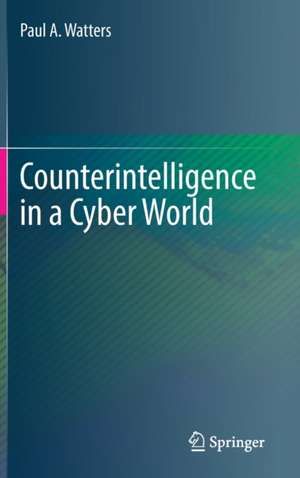Counterintelligence in a Cyber World
Autor Paul A. Wattersen Limba Engleză Hardback – 27 iun 2023
A range of approaches to web and forum surveillance are outlined as a virtual addition to traditional video and audio surveillance captured regarding targets. This includes a description of the advances in Artificial Intelligence, predictive analysis, support for the disciplines of digital forensics, behavioural analysis and Open Source Intelligence (OSINT). The rise of disinformation and misinformation and the veracity of widespread false flag claims are discussed at length, within the broader context of legal and ethical issues in cyber counterintelligence.
This book is designed for professionals working in the intelligence, law enforcement or cybersecurity domains to further explore and examine the contemporary intersection of these disciplines. Students studying cybersecurity, justice, law, intelligence, criminology or related fields may also find the book useful as a reference volume, while instructors could utilise the whole volume or individual chapters as a secondary textbook or required reading.
| Toate formatele și edițiile | Preț | Express |
|---|---|---|
| Paperback (1) | 369.38 lei 3-5 săpt. | +14.56 lei 7-13 zile |
| Springer International Publishing – 28 iun 2024 | 369.38 lei 3-5 săpt. | +14.56 lei 7-13 zile |
| Hardback (1) | 366.77 lei 3-5 săpt. | +20.05 lei 7-13 zile |
| Springer International Publishing – 27 iun 2023 | 366.77 lei 3-5 săpt. | +20.05 lei 7-13 zile |
Preț: 366.77 lei
Preț vechi: 436.62 lei
-16% Nou
Puncte Express: 550
Preț estimativ în valută:
70.20€ • 73.17$ • 58.44£
70.20€ • 73.17$ • 58.44£
Carte disponibilă
Livrare economică 14-28 decembrie
Livrare express 30 noiembrie-06 decembrie pentru 30.04 lei
Preluare comenzi: 021 569.72.76
Specificații
ISBN-13: 9783031352867
ISBN-10: 3031352866
Pagini: 145
Ilustrații: XIX, 145 p.
Dimensiuni: 155 x 235 x 17 mm
Greutate: 0.42 kg
Ediția:2023
Editura: Springer International Publishing
Colecția Springer
Locul publicării:Cham, Switzerland
ISBN-10: 3031352866
Pagini: 145
Ilustrații: XIX, 145 p.
Dimensiuni: 155 x 235 x 17 mm
Greutate: 0.42 kg
Ediția:2023
Editura: Springer International Publishing
Colecția Springer
Locul publicării:Cham, Switzerland
Cuprins
Chapter. 1. Counterintelligence Theory.- Chapter. 2. The Cyber Operational Environment.- Chapter. 3. Cyber Threats (and Opportunities).- Chapter. 4. Psychology and Criminal Profiling.- Chapter. 5. Counterespionage.- Chapter. 6. Technical Surveillance.- Chapter. 7. Physical Surveillance.- Chapter. 8. Data Analysis.- Chapter. 9. Attack Attribution.- Chapter. 10. Practical Deception.- Chapter. 11. Legal Issues in Cyber Counterintelligence.- Chapter. 12. Ethical Issues in Cyber Counterintelligence.
Notă biografică
Professor Paul A. Watters PhD is a trusted cybersecurity advisor and thought leader based in Melbourne, Australia. He is CEO at Cyberstronomy, and provides strategic cybersecurity guidance to a range of government and private sector clients.
Professor Watters is also Academic Dean at Academies Australasia Polytechnic, an ASX-listed education provider (ASX:AKG), Strategic Cyber Consultant at Ionize, and inventor of the 100 Point Cyber Check. Professor Watters is also Honorary Professor at Macquarie University and Adjunct Professor at La Trobe University. He is a Chartered IT Professional, a Fellow of the British Computer Society, a Senior Member of the IEEE, Member of the ACM, and a Member of the Australian Psychological Society. Professor Watters is a graduate of the University of Cambridge, and an active member of the Senate of the University.
Textul de pe ultima copertă
This book provides an outline of the major challenges and methodologies for applying classic counterintelligence theory into the cybersecurity domain. This book also covers operational security approaches to cyber, alongside detailed descriptions of contemporary cybersecurity threats, in the context of psychological and criminal profiling of cybercriminals. Following an analysis of the plethora of counterespionage techniques that can be mapped to the cyber realm, the mechanics of undertaking technical surveillance are reviewed.
A range of approaches to web and forum surveillance are outlined as a virtual addition to traditional video and audio surveillance captured regarding targets. This includes a description of the advances in Artificial Intelligence, predictive analysis, support for the disciplines of digital forensics, behavioural analysis and Open Source Intelligence (OSINT). The rise of disinformation and misinformation and the veracity of widespread false flag claims are discussed at length, within the broader context of legal and ethical issues in cyber counterintelligence.
This book is designed for professionals working in the intelligence, law enforcement or cybersecurity domains to further explore and examine the contemporary intersection of these disciplines. Students studying cybersecurity, justice, law, intelligence, criminology or related fields may also find the book useful as a reference volume, while instructors could utilise the whole volume or individual chapters as a secondary textbook or required reading.
A range of approaches to web and forum surveillance are outlined as a virtual addition to traditional video and audio surveillance captured regarding targets. This includes a description of the advances in Artificial Intelligence, predictive analysis, support for the disciplines of digital forensics, behavioural analysis and Open Source Intelligence (OSINT). The rise of disinformation and misinformation and the veracity of widespread false flag claims are discussed at length, within the broader context of legal and ethical issues in cyber counterintelligence.
This book is designed for professionals working in the intelligence, law enforcement or cybersecurity domains to further explore and examine the contemporary intersection of these disciplines. Students studying cybersecurity, justice, law, intelligence, criminology or related fields may also find the book useful as a reference volume, while instructors could utilise the whole volume or individual chapters as a secondary textbook or required reading.
Caracteristici
Provides guidance on how to organize and operate a counterintelligence program Easy-to-follow instructions on how to translate lessons learned from government counterintelligence Examines the limitations of attack attribution and post-attack forensics
